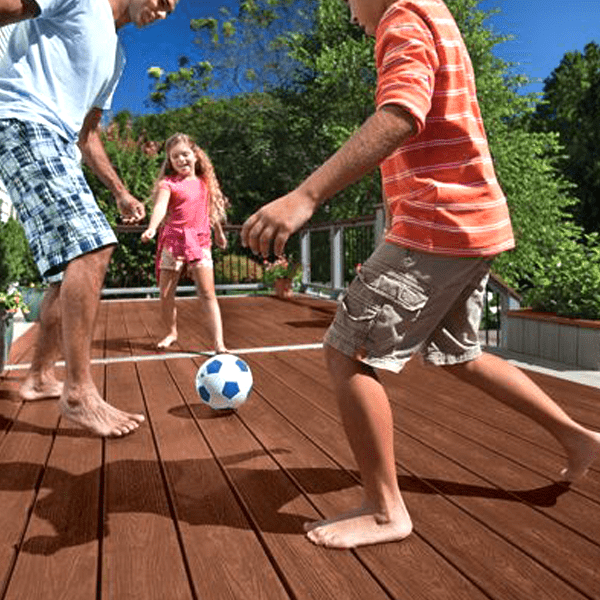No products in the basket.
Decking finish problem – sticky problem
We have already covered the problems with the rubber surface in detail. However, some problems are more common – and cause more heartache – than others. This week we’re going to tackle the common stickiness problem where, for some reason, the top oil you apply doesn’t do what it says on the tin. We’ll also look at how to remove old finishes so you can put lots of nice oil back on, and give some sensible advice on what NOT to do!
Sticky garden terrace – what to do?
You do the decent thing and keep your garden deck in apple pie order. But when it comes to actually applying the decking oil, or applying more coats, everything seems to go pear-shaped. It sits on the surface instead of being absorbed and you end up in a proper pickle. What is this terrible stickiness all about and how can you fix it?
4 reasons deck oil gets sticky
- Overapplication – when the oil does not penetrate the surface properly.
- Problems using an oil over an incompatible product such as a base stain, varnish or paint.
- Not enough preparation – for example trying to use a decking oil over mold or algae.
- Problems with new hardwood decks that are inherently oily.
What is the problem?
If the deck oil you’re applying has become sticky and isn’t absorbing properly, your main reason – assuming it’s a new deck – might be the type of wood the deck is made of.
If it’s a brand new deck, is it made out of hardwood? If so, it could already be naturally oily. That said, there’s probably nothing wrong at all – the wood might be oily enough in the first place, or even pre-treated with an oil. Some new hardwoods, particularly exotic ones, are very oily by nature and you will find that they absorb very little if any oil, at least until they have aged a little and seen at least 3 months of our famously terrible British weather!
Overuse is easy. If your deck happily picked up a lot of oil and then suddenly stops, it’s probably because the wood is already “full” and can’t take any more. All you have to do is stop trying to apply more and wipe away any excess with a lint-free cloth.
Some people try to take shortcuts or don’t quite understand how different decking products work, e.g. B. when trying to put an oil over an incompatible patio stain, varnish or even paint. If you think about it, stop immediately – it just won’t work! Decking oils only work on bare wood or previously oiled decking boards. If your garden deck has been treated with a product that forms a protective film on the surface, sometimes characterized by cracking or flaking chips, it must be completely removed before adding a decking oil.
The same applies to mold and algae. It might be tempting to just smear deck oil over it and hope it goes away, but it doesn’t work. Mold and algae penetrate the surface, they don’t just sit on the wood. And oiling them won’t kill them, they are living things and they only die if treated with a special wood fungicide and mold killer like Barrettine Mold and Mildew Cleaner.
Many of the best wood antifungals will kill the mold or algae and also prevent it from coming back. This is an excellent idea and will save you more time between maintenance sessions.
How to remove decking oil
If you’ve gone too far and need to remove deck oil or want to remove an old deck oil and use a different end product like a stain or varnish, how do you go about it?
Oils penetrate the wood and don’t just sit on the surface. Although it is easy enough to sand down to surface level, it is very difficult to get the product out of the grooves. If your deck is oiled, it’s best to use a different oil rather than trying to remove it and replacing it with a stain or color. Finally, oils are the best product for decking because they penetrate the wood longer and protect it so much better than something that just sits on the surface and allows the beautiful natural wood grain to show through.
There’s a lot of talk online about getting rid of deck oil and replacing it with stain or paint, but the advice is always the same – it’s a tall order and you’re probably best off leaving it alone. You could try white spirit or a jet washer, but even they are far from ideal. It’s best to stick with oils. Here’s why…
- Sanding will only work if the deck is smooth and not grooved and no oil is being removed from the grooves.
- You can use a jet washer to clean oil finished patios. However, this also comes with its own risks. You can damage the wood surface or contaminate the soil as the powerful jet of water pushes the surface out of the wood onto plants and into the soil.
- If you really want to finish your decking with a sealer (although sealers aren’t the best idea for decking), you might be able to remove your oil-based finish with mineral spirits… on the other hand, you might not, and it’s a lot of work.
The easy way – replacing other pad surfaces with oil
Rather than trying to remove an oil finish and replacing it with something that doesn’t work as well – like stain or varnish – it’s always easier to remove a non-oil finish and replace it with decking oil. A deck scraper, for example, is a great way to remove a lot of deck stains and paint so you can replace it with a nice oil.
Make life easier with a good decking oil
If you want to top up a previously oiled base with a fresh coat of oil – which we recommend – it’s a much easier task. You don’t even have to remove all the old oil. Simply clean the surface thoroughly with a good quality patio cleaner that will remove the dirt and then re-oil. 2-3 coats should do the trick. If you are looking for a high-quality decking oil, we recommend Holzol Decking Oil.
So you keep a perfect deck oil longer
The better you maintain your deck, the less often you usually need to re-oil it.
- You can’t hit a simple brush at first to keep the wood surface free of mud, dirt, leaves, etc. Regular sweeping has a major impact on the lifespan of a deck.
- Cleaning is your next task. Use a patio cleaner regularly to remove moss, mold and algae and prevent regrowth for up to six months.
- Always finish your deck with oil when it looks tatty or worn to prevent damage before it occurs.

